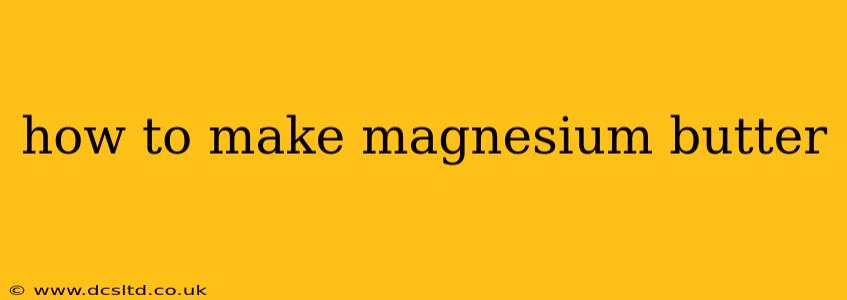Magnesium butter is a luxurious and effective way to absorb magnesium topically. Unlike magnesium oil sprays, which can sometimes be irritating, magnesium butter offers a gentler, more moisturizing application. This comprehensive guide will walk you through the process of making your own magnesium butter at home, covering everything from choosing the right ingredients to understanding its benefits.
What is Magnesium Butter?
Magnesium butter is a blend of magnesium chloride flakes and a carrier oil, typically shea butter, cocoa butter, or coconut oil. The carrier oil acts as a base, softening the skin and allowing for easier absorption of the magnesium. This combination creates a creamy, easily spreadable butter that's perfect for massage or topical application.
Why Make Your Own Magnesium Butter?
Making magnesium butter at home offers several advantages:
- Control over ingredients: You can choose high-quality, unrefined oils and ensure your product is free from artificial fragrances, preservatives, and other potentially harmful additives.
- Cost-effectiveness: Homemade magnesium butter is generally cheaper than commercially available options.
- Customization: You can tailor the recipe to your specific needs and preferences by adjusting the ratio of magnesium flakes to carrier oil or adding essential oils.
Ingredients You'll Need:
- Magnesium Chloride Flakes: This is the key ingredient that provides the magnesium benefits. Ensure you purchase food-grade magnesium chloride flakes.
- Carrier Oil: Choose your preferred carrier oil. Popular choices include:
- Shea Butter: Rich, moisturizing, and excellent for dry skin.
- Cocoa Butter: Hydrating, with a slightly chocolatey scent.
- Coconut Oil: Versatile, readily available, and has antimicrobial properties. Note that it will solidify at room temperature.
- Mango Butter: Rich in vitamins and antioxidants.
- Optional additions: Essential oils (lavender, chamomile, etc.) can add fragrance and therapeutic benefits. However, always perform a patch test before applying to a larger area.
How to Make Magnesium Butter: A Step-by-Step Guide
Step 1: Gather your ingredients and equipment. You'll need a double boiler or heat-safe bowl and whisk, along with your chosen ingredients.
Step 2: Melt the carrier oil(s). Gently melt your chosen carrier oil(s) in a double boiler or heat-safe bowl set over a pan of simmering water. Avoid direct heat, as this can degrade the quality of the oils.
Step 3: Add magnesium chloride flakes. Once the oil is completely melted, gradually add your magnesium chloride flakes, whisking constantly to prevent clumping. The amount of magnesium chloride will depend on your preference and the type of carrier oil used. A good starting point is a 1:1 ratio by weight (e.g., 1 ounce of shea butter and 1 ounce of magnesium chloride flakes). Experiment to find the right concentration for your skin.
Step 4: Continue whisking. Continue whisking until the magnesium chloride flakes are fully dissolved and the mixture is smooth and creamy.
Step 5: Add essential oils (optional). If using essential oils, add them now and stir well to combine.
Step 6: Pour into containers. Pour the magnesium butter into clean, airtight containers. Allow it to cool and solidify completely before using.
How to Use Magnesium Butter
Apply a thin layer of magnesium butter to the desired area of skin. Start with a small amount and increase as needed. It's best to apply it at night and allow it to absorb overnight. Remember to wash your hands after application.
What are the benefits of magnesium butter?
Magnesium butter offers several potential benefits, including improved sleep quality, reduced muscle soreness and tension, and better skin hydration. However, it's important to note that topical magnesium may not be as effective as oral supplementation for managing magnesium deficiencies. Always consult your doctor if you have concerns about magnesium levels.
Can I use magnesium butter on my face?
Yes, but start with a small amount on a patch test to check for any adverse reactions. Some people find that certain oils, like coconut oil, are comedogenic (pore-clogging), so be mindful of the carrier oil you select for facial application.
How long does magnesium butter last?
Homemade magnesium butter typically lasts for several months if stored properly in a cool, dark place in an airtight container.
What are some alternative ways to use magnesium?
While magnesium butter is an effective topical application method, magnesium can also be ingested through supplements or obtained through diet. Speak with your physician or a registered dietician to determine the best approach for your individual needs.
By following this guide, you can easily create your own high-quality, customized magnesium butter, allowing you to enjoy the potential benefits of topical magnesium application in a luxurious and effective way. Remember to always perform a patch test before applying to a larger area of skin and consult your healthcare provider if you have any concerns.
